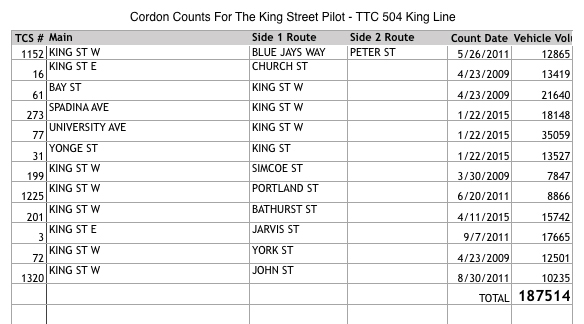There's a couple of blog posts of interest, calling into question the City's numbers related to the pilot project. I'd love to hear the resident experts' take on them.
Here are some excerpts; [bracketed] and bold text are mine. Later clarifications, based on replies to this post, are bracketed and dated.
http://algorithmicculture.com/the-king-street-pilot-lie/
it’s clear the methodologies used for both public transit and vehicles are different in how they’re being presented to the public: 65K+ passengers traverse along the entire 14 km stretch of the 504 line, not the Pilot zone; 20K vehicles is even more suspicious as the cordon data provided by the City shows a tally of 21K+ vehicles traversing at only one intersection in the Pilot zone over an 8 hr window. In short, if you were to tabulate the correct numbers for the same areas and times, the numbers would favor passengers in vehicles, not transit riders. […]
[Jan. 26] The conclusion is a teaser of things to come, based on later statements; it doesn't strictly follow from the quote above.
According to one 2014 TTC report of passenger “ons and offs” along the 504 King line, approximately 37% did not traverse through the zone and approximately 38% of the 65K ridership did not traverse through the zone all day. The number of transit riders in the zone during peak hours is closer to 20-22K, similar to the vehicle count of 20K. Where’s the 3:1 ratio? […]
cordon data provided by the City shows vehicle traffic at King & Bay streets (with a one-day 8hr tally) totaling 21,640 vehicles; this fact immediately disproves the suggestion that only 20K vehicles touch the 504 line, especially the entire 14 km stretch. […]
When you factor in 1.2 passengers for the private vehicle count, you have 24K vehicle passengers. That leaves a 24K passenger count for private vehicles and approximately 20-22K 504 King line passengers for peak hours (in any case a ratio more 1:1 if we are to take the “20K” figure by the City as fact); while the comparison outside of peak hours immeasurably favours vehicles over transit. Also, the cordon counts for vehicles were dated, in some cases almost ten years old, so the numbers are conservatively low. […]
As someone who is a strong advocate for public transit, I still have to take issue with the deception of the data that launched the Pilot and on the very idea itself that the Project would be a solution to congestion in the city. On both of these principles, I felt compelled to address the lies. […]
He* cites Melbourne, Montreal, Bogota… so he's apparently not ignorant of transit issues.
http://algorithmicculture.com/king-street-pilot-lie-part-2-the-integrity-behind-the-numbers/
The cordon counts provided by the City along this stretch [the entire 14-km 504 King line —SG] includes 40 intersections, and the 8hr total exceeds 480,000 vehicles counted. Now, one still has to understand that there’s a likelihood of vehicles repeating in such counts, thus a simple addition of these counts would be inaccurate. […] to go from 480,000 to 20,000 is an extreme consideration of vehicle repetition along such a distance of road that covers diverse communities (commercial, residential, etc.) where much of that traffic is localized; that is to say, in order to reach 20K from 480,000, the City has excluded 96% of the total count! Ergo, 20,000 vehicles appears, even to the untrained eye, as completely arbitrary. […]
[Jan. 26] He didn't take one cordon count and multiply by the number of cordons along the entire 504 King route; he added all the City's individual cordon counts along the route. (
Image 1,
Image 2)
These are bold claims, which have been quoted on Twitter with the #ReverseKingCarBan hashtag. Clearly, his logic is flawed: when a rush-hour streetcar drives through the pilot-project area 3 minutes faster, it picks up passengers along the rest of the line 3 minutes sooner — thus, their own total travel time decreases by 3 minutes, regardless whether they're travelling through the pilot area or not. The only way that faraway riders wouldn't benefit is when the streetcar is short-turned. I'm curious, what portion of 504 trips are short-turned?
So, what do you think? Is his analysis sound or flawed? In what way? Do we have some details on how the City derives the 20K-vehicle figure?
I'd love to fact-check Twitter mentions of this analysis, but want the real goods from UT to ensure my points are solid.
(* The unsigned posts probably come from "mark j" or "derek a. fisher", so I used "he" and "his".)





